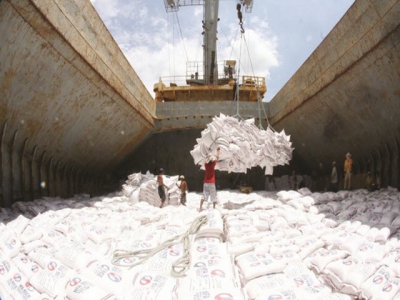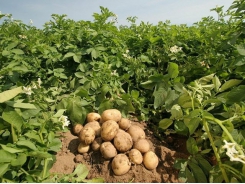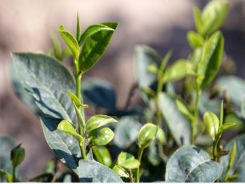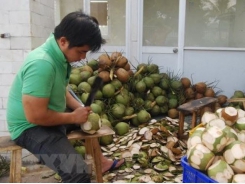Hard to export rice to China

Since the beginning of the year, rice export has been quite positive, recording positive signals in many markets. Particularly, the leading rice export market is China, but the "reverse wind" when the export turnover decreased markedly forecasts that rice export is becoming more and more difficult.
Strengthening to control China's rice imports will cause significant difficulties for Vietnamese rice exports. Picture: ST.
Dramatical reduction of both quantity and value
According to the latest statistics from the Department of Agricultural Product Processing and Marketing (Ministry of Agricultural Rural Development): By the end of July, rice export was estimated at 3.9 million tons and nearly USD 2 billion, up 12.2% in volume and an increase of 29.2% in value over the same period in 2017. Price of rice export in the first half of the year reached 508 USD / ton, up 14.2% over the same period last year.
In the first half of this year, China continued to rank first in Vietnam's rice market with a 26.8% market share, followed by Indonesia with 18.2% market share and the Philippines with a market share of 10.4%. Notably, the export of rice to markets such as Iraq, Malaysia, Philippines and Ivory Coast, increased sharply over the same period last year with value and increase respectively of $ 85.5 million, 2.5 times; USD 138.2 million, 2.1 times increase; USD 183.4 million, an increase of 76.8% and USD 66.4 million, an increase of 16.8%. In the first half of this year, rice exports to China reached 891.7 thousand tons, equivalent to 474.8 million USD, down 27.4% in volume and 14.6% in value.
It is not only in the "picture" of the overall export based on the statistics on quantity and value, when considering deeply to look at the structure of export items, difficulties and mistakes in rice export to China market are also shown quite clearly. Specifically, in the first half of the year, export turnover of 5% broken white rice reached 550.4 million, accounting for the highest rate of 30.8%, mainly exported to Indonesia and the Philippines. The second highest value was exported with 472.6 million USD, accounting for 26.5%, mainly in China, Ghana and Iraq. Sticky rice ranked fourth after 15% broken white rice with export value of 249.3 million, accounting for 13.9%.
Representatives of the Department of Agricultural Product Processing and Marketing, said that China is still the largest market for sticky rice in Vietnam with a market share of over 80%. However, since July, China has increased tariffs on non-quota imported sticky rice from 5% to 50%, which has led to a steep decline in exports of glutinous rice with export prices of US $ 50-60 per ton compared to before the tax application when it was $ 425 - 435 per ton. In addition to the tariff increase policy applied to sticky rice, the export of rice to China is also affected as this market strengthens import control and enhances standards for Vietnamese exporters.
Attempt to meet requirements
Actually it is not just until the present time that exporting rice to China has been strictly controlled and faced with many difficulties. At the end of 2016, China sent a team of experts to evaluate 31 Vietnamese rice producers and processors registered with MARD to export rice to China. Through inspection, from January 1, 2017, China officially agreed to allow a total of 22 Vietnamese enterprises to export rice to China. These companies had to strictly comply with the Chinese regulations and strict quarantine of shipments before export. Present information is not very optimistic, until the beginning of this year, 3/22 of the above enterprises have been notified by the Chinese to suspend rice exports to China, because these enterprises were found to have grains of grass exceeding the prescribed level.
Dr. Tran Ngoc Thach, Director of the Cuu Long Delta Rice Institute, said that since the beginning of the year, demand for seafood has been increasing in China and South East countries. According to statistics, each year China consumes 140 million tons of rice. This is a good opportunity for Vietnam to export to this market.
Obviously, the Chinese market is quite wide open, but clearly with rice in particular, and other agricultural products in general, China is not an "easy" market any longer. The country is increasingly strictly controlling imports, considering and respecting the quality of products. From now to the end of the year, the Department of Agro-product Processing and Market Development said that the Chinese market increase of import tariffs and enhanced quality control is an important factor that makes the rice industry face many difficulties for increasing export.
With such a long time in first position in the rice export market of Vietnam, the importance of the Chinese market is undeniable. The difficulty in exporting rice to China is also easy to see. However, some experts point out that China has increased its border control and shifted to import-export in order to manage its quality, while avoiding tax losses.
In fact, Vietnamese enterprises with good investment want to export for long-term business to avoid risks. Therefore, it should not be assumed that the Chinese side makes it difficult for Vietnam. In contrast, the key is that enterprises must consider how to comply with the requirements of food safety, traceability of importing countries to meet the requirements of exporting goods. The Department of Agro-Products Processing and Market Development advises: In addition to focusing on promoting the quality of export rice, businesses need to promote and seek new export markets, avoiding dependence on the Chinese market.
Related news
Tools

Phối trộn thức ăn chăn nuôi

Pha dung dịch thủy canh

Định mức cho tôm ăn

Phối trộn phân bón NPK

Xác định tỷ lệ tôm sống

Chuyển đổi đơn vị phân bón

Xác định công suất sục khí

Chuyển đổi đơn vị tôm

Tính diện tích nhà kính

Tính thể tích ao




 Bac Giang enjoys bumper litchi crop
Bac Giang enjoys bumper litchi crop  Trà Vinh promotes farming of key crops
Trà Vinh promotes farming of key crops